Tree hydrangea Magic Pinkerbell - how to care for a shrub
The vibrant perennial hydrangea Magical Pinkerbell was bred by a Dutch florist 10 years ago. It was planted only in royal gardens, and since 2018 it has become widespread in private gardening around the world. Consider the main characteristics of the variety, the rules of cultivation and care.
- general description
- Landing rules
- Timing
- Seat selection
- Purchase and preparation of seedlings
- Landing technique
- Necessary activities
- Watering
- Top dressing
- Pruning
- Care features
- During flowering
- After flowering
- Preparing for winter
- Reproduction
- Cuttings
- By dividing the bush
- Stem layering
- Diseases and pests
- Application in garden design
- Variety reviews
- Useful videos
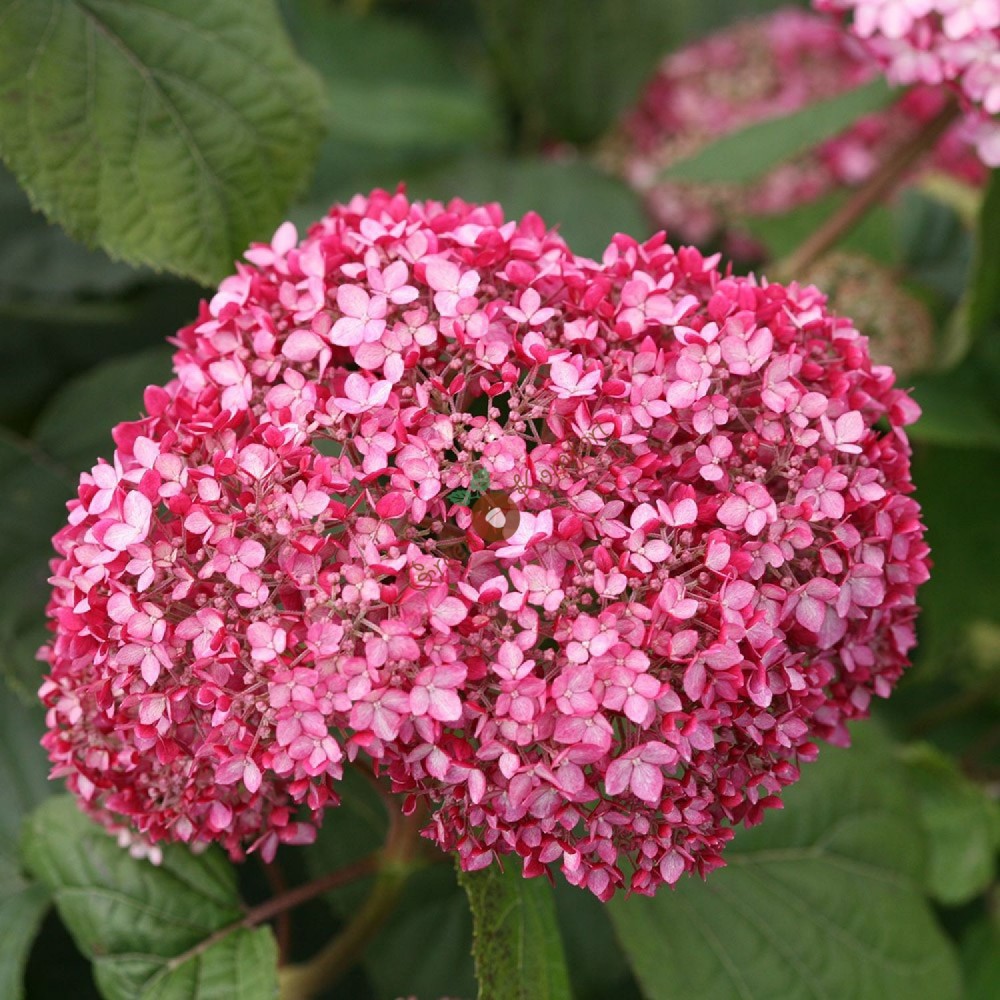
Hydrangea tree magical
general description
Treelike hydrangea Magical Pinkerbell (lat.hydrangea arborescens magical pinkerbell) is an ornamental culture that blooms from early summer to mid-autumn.
The variety has good frost resistance and winter hardiness.
It grows in the form of a spherical shrub with strong lignified branches, height - 1.2 m, circumference - 1.3-1.4 m.
The leaves are ovoid, during the growing season of an emerald tone, closer to autumn they acquire a yellow tint. Inflorescences - dense dense panicles, bloom in the first half of June at the top of each stem;
The flowers are small, bright pink, some are snow-white, which gives the buds a contrasting look.
After the end of flowering, green fruits are formed in place of flowers, but they are not suitable for growing new plants.
Landing rules
There are no fundamental differences in the cultivation of this culture from other varieties of tree hydrangeas. The main thing is to meet the deadlines and the planting scheme and select high-quality planting material and soil.
Timing
The most suitable time for planting this crop is spring (from mid-March to the first half of April).
When grown in zones with a warm and temperate climate, planting can be carried out in the fall, until September 15, so the seedlings will have time to adapt to a new place and prepare for winter.
Seat selection
It is better to plant hydrangeas in a sunny area, but with protection from the scorching rays at lunchtime. A suitable place would be a corner where the sun shines in the morning and evening. When planted in the sun, flowers and leaves can get burned.
The soil needs light, well-drained, with a high content of organic matter, minerals and a high level of acidity.
You can plant a shrub on loamy soil with the addition of sand or perlite - two buckets per 1 m². If you are going to grow on sandy loam, you need to add 20 kg of clay to the same area.
Choose a windless place with a deep passage of groundwater - up to 3 m, otherwise the bush will quickly dry out or rot.
Purchase and preparation of seedlings
You can purchase planting material in one of the specialized nurseries. In such a place, you will get a real variety with all the characteristics.
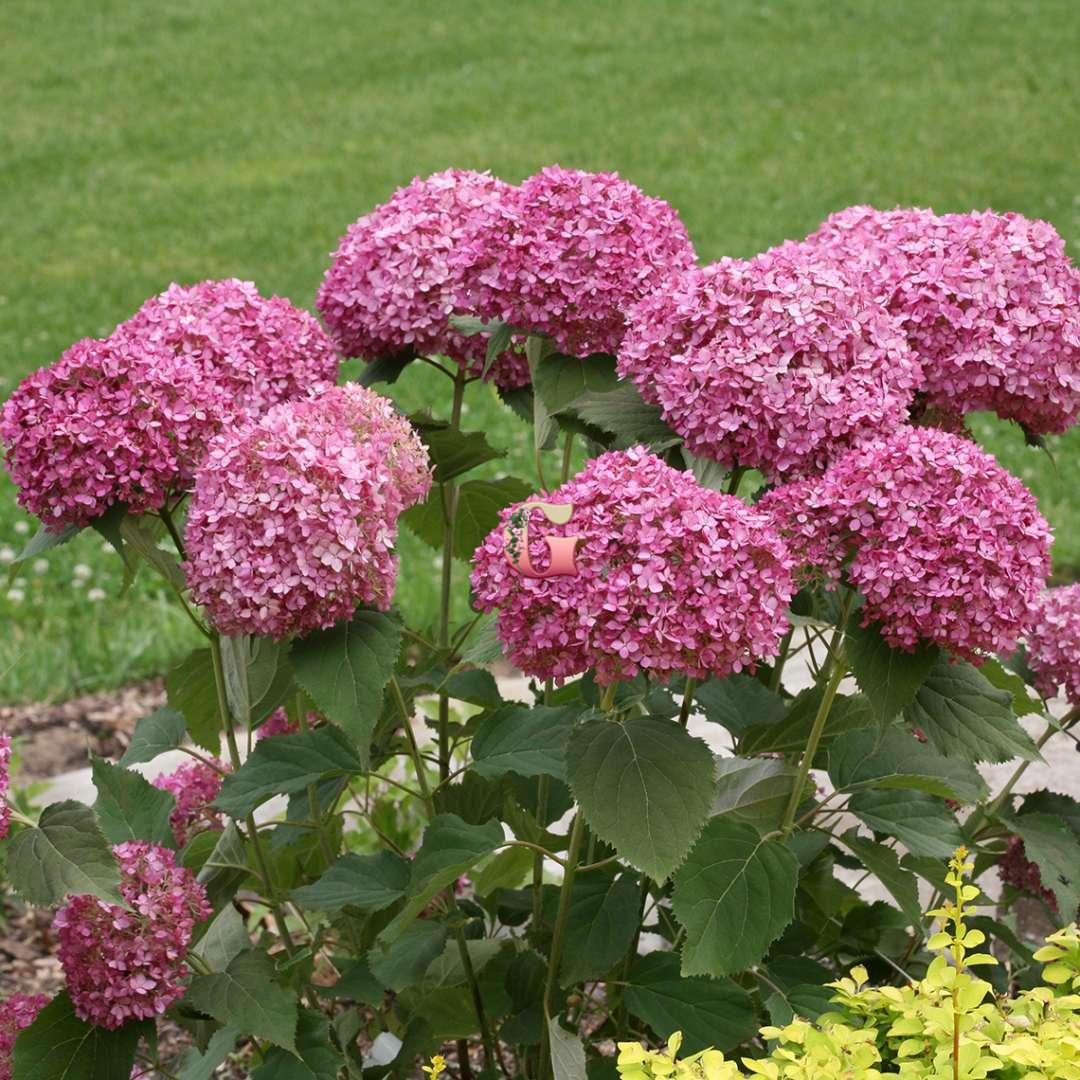
Hydrangea Magic Pinkerbell
When choosing a bush for your own garden, carefully examine its crown - all stems, leaves, buds should be fresh, juicy, without mechanical injuries and signs of disease.
Give preference to grown specimens with several shoots, they have a well-developed root system, so they will safely survive planting in open ground.
As a rule, bushes are sold with an earthen ball or in a container. Before planting, they are soaked in cold water. Then the roots are trimmed to 2-3 cm in length to stimulate the rapid growth of new processes.
Landing technique
The pits are harvested 2-3 weeks before planting, so that the soil and the laid down nutrients have time to settle.
The approximate parameters of the holes are 60x70x80 cm. The main thing is that they are larger in terms of the volume of the root system.
A little drainage from pebbles, rubble and dropouts is poured into the bottom of each hole. A fertile composition is poured on top - a bucket of dug earth is mixed with 5 kg of rotted manure, 100 g of lime, 50 g of chalk, 100 g of superphosphate and 40 g of potassium nitrate. In order not to burn the roots, the soil mixture is sprinkled with a thin layer of garden soil, forming a mound.
The roots are lowered, straightened in different directions, sprinkled with earth to the top so that there are no voids, tamped. When planting, it is important not to deepen the root collar, otherwise it will quickly rot and the seedling will die.
The bushes are watered abundantly with warm water - the consumption of one copy is 10 liters. To prevent rapid evaporation of moisture, mulch with peat, compost or last year's manure. In the first weeks, they need shading from the scorching sun - at lunchtime they cover with burlap or agrofibre.
For group planting, it is necessary to maintain a distance between seedlings - at least 1.5 m, in a row - 1.3 m.
Necessary activities
Watering
In the first month, for successful rooting, the seedlings are watered every day (consumption - a bucket of water under the bush). The procedure will help to take root faster and stimulate the growth of the aerial part.
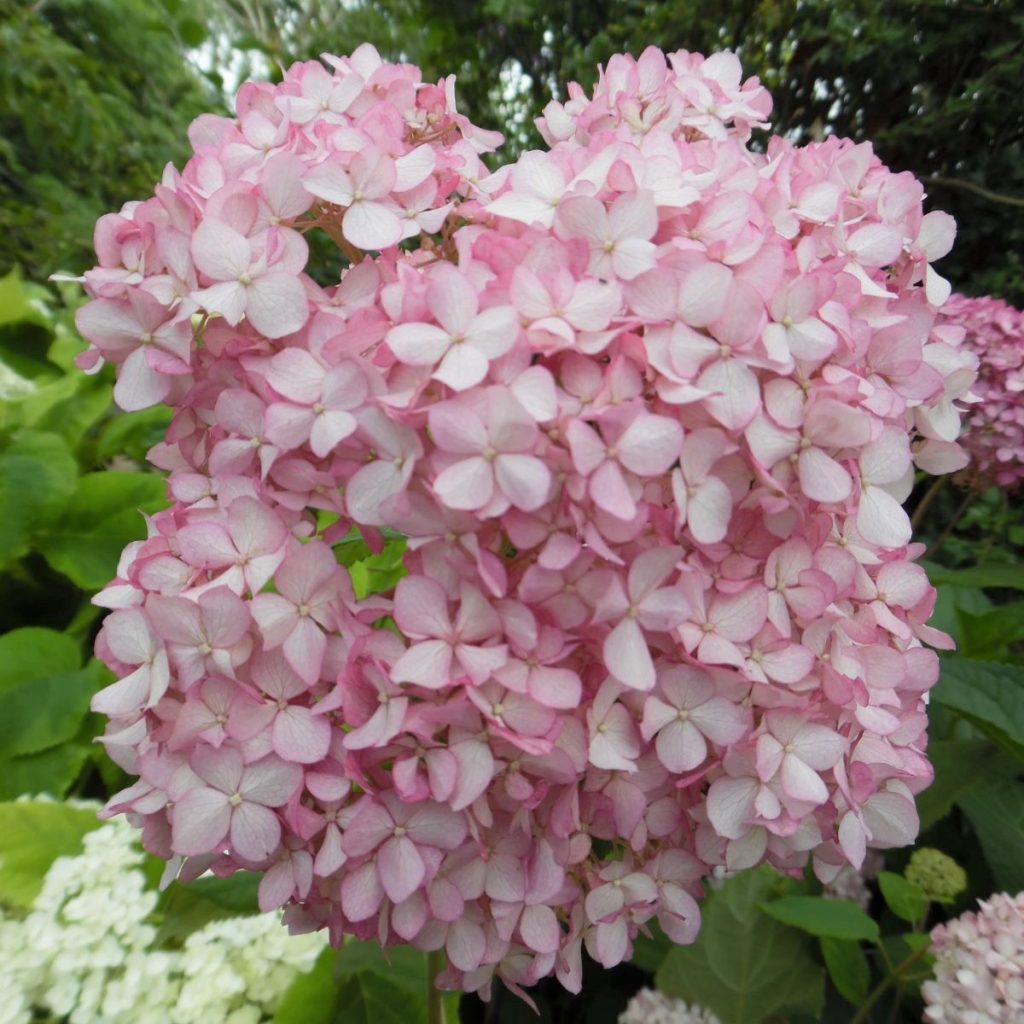
Hydrangea tree magical pinkerbell
Then they moisten as the soil dries to a depth of 5-6 cm. If the summer is rainy, watering can be excluded, because from waterlogging, the root system begins to rot.
Adult shrubs that have begun to bloom are moisturized according to the following scheme:
- in early spring, before the start of sap flow;
- two weeks before budding;
- after flowering;
- in the fall, when the bush will drop foliage.
Use at least 20 liters of water D. additionally moisten as the surface layer of the soil dries out.
After the procedure, the near-trunk zone is loosened to a depth of 5-6 cm. This will help maintain the moisture and breathable qualities of the soil. Weeds are removed, aisles are weeded. They also add mulch from peat or humus so that moisture remains in the ground for as long as possible.
Top dressing
If you want to achieve maximum decorativeness, the hydrangea must be fed regularly. The first food is introduced in the third year, when all nutrients are exhausted.
- In early spring, before the onset of swelling of vegetative buds, ready-made preparations are used to fertilize rhododendrons, azaleas and hydrangeas.
- In the summer, when the plant begins to form buds, fertilizing is made from phosphorus and potassium. These components prolong the life and improve the quality of flowering.
- In the fall, when the shrub blooms and sheds foliage, compost or last year's manure is embedded in the near-trunk zone.
Each root nutrition is carried out together with abundant watering - this helps to quickly assimilate nutrients and prevent root burning.
Pruning
This procedure is carried out in early spring or late autumn. All weakened, dried, broken off and damaged branches are cut out.
To improve bushiness, you can carry out a light shaping - cut woody branches to 4-5 buds. This manipulation has been carried out for several years.
In summer, shoots that grow inside the crown or at the wrong angle are cut off.
Pruning is carried out using a sharp and sterile tool, after which the bush is treated with a solution of copper sulfate. This substance protects against infections.
Care features
During flowering
During this period of life, it is important to ensure that the soil does not dry out. Therefore, regular, but moderate watering is carried out. With a lack of moisture, the bushes release small and not so bright inflorescences; from the excess, the hydrangea can stop blooming. In the flowering phase, feeding is stopped, since it also inhibits the setting and blooming of buds.
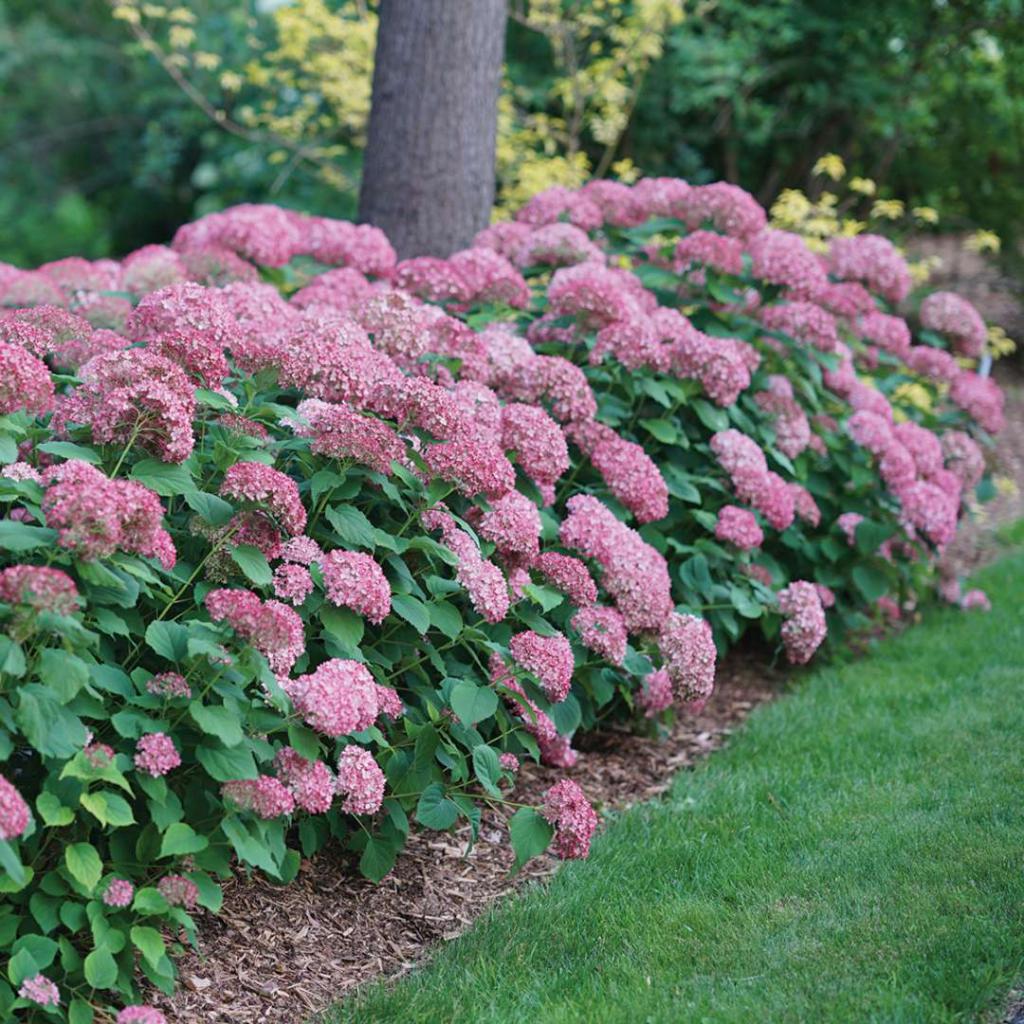
Hydrangea Medical Pinkerbell
After flowering
A plant that has faded goes into a dormant phase, so it is not fertilized, watered less often than usual - once every 15-20 days. All shrunken inflorescences are cut off, which only take away strength and slow down the process of recovery of the bush.
Preparing for winter
This is one of the important stages of caring for young plantations, since they have a weak resistance to winter cold.
2 weeks before the onset of the first frost, the lower part of the stems is treated with slaked lime. Then mulch with a thick layer of peat, compost or last year's manure, forming a mound 15 cm high.
After the autumn pruning, the remaining branches are neatly tied with a rope or twine in a bundle, bent to the ground, and pinned. Sprinkle on top with fallen leaves, sawdust, cover with slate or spruce branches.
Under such a shelter, seedlings are kept until spring. As the snow melts, the street temperature stabilizes at around 5-7 ° C, the insulation material is removed, the branches are untied.
Adult shrubs from three years old do not need shelter, the only thing that can be done is to mulch the near-trunk circle.
Reproduction
Hydrangea is propagated in several ways, each gives a positive result, subject to all the rules for harvesting, planting and caring for planting material.
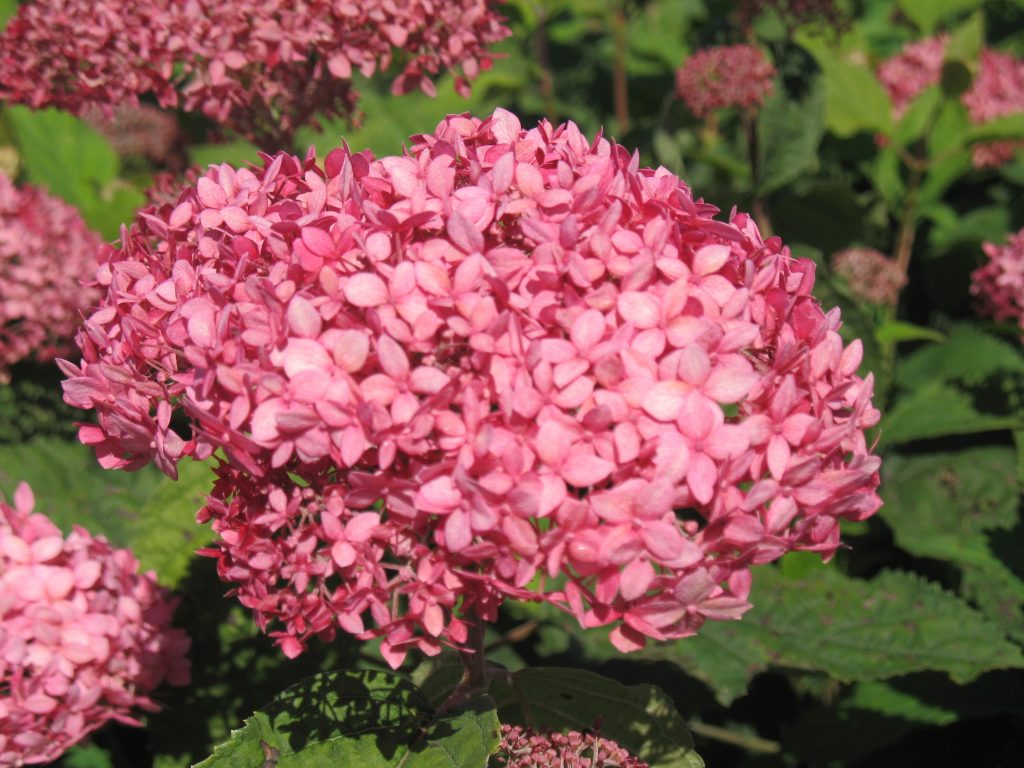
Hydrangea tree medical pinkerbell
Cuttings
Cuttings are cut in spring or summer. The apical parts of the current year are taken from last year's shoots. The main requirements are a length of at least 15 cm, the presence of several leaves and buds.
The leaves at the bottom of each blank are removed, then dipped for an hour in Kornevin or Heteroauxin. They are planted in seedling boxes filled with a moist mixture of peat and sand to a depth of 3-4 cm.
The seedlings are watered, covered, placed in a warm place with diffused light. They are ventilated daily, and moistened as the soil dries.
The appearance of new leaves after 2-3 weeks is a sure sign of successful rooting. Then the film is removed, they grow at home for another month, then they are planted in the garden.
By dividing the bush
This breeding is suitable for old shrubs that have stopped growing, bloom poorly and need rejuvenation.
Hydrangea is watered abundantly, after an hour, when the soil is wet, dug out. The roots are washed from soil residues, dried. With a garden shovel, the rhizome is cut into several parts, so that each has 2-3 roots and one shoot with buds and leaves. Places of cuts are sprinkled with charcoal, planted in the same way as purchased plants.
Stem layering
For successful reproduction by layering in the fall, you will need a shrub with low branches to the ground. It is important that they are lignified and flexible.
Take the strongest and longest branch, remove all the foliage on it. They are lowered into a pre-dug hole to a depth of 5-6 cm.
Top covered with a fertile composition - mix sand, peat and last year's manure (compost) in a ratio of 1: 1: 1. Moisten with warm water.
On the eve of frost, sprinkle with a thick layer of fallen leaves, sawdust to protect the layers from freezing.
In the spring, as soon as the above-zero temperature is normalized, it is dug up, separated from the mother bush. Cut with pruning shears into several parts with roots, seated separately in the garden.
Diseases and pests
Tree hydrangea Medical Pinkerbell is rarely damaged by diseases, the main cause of infection is violation of agricultural practices:
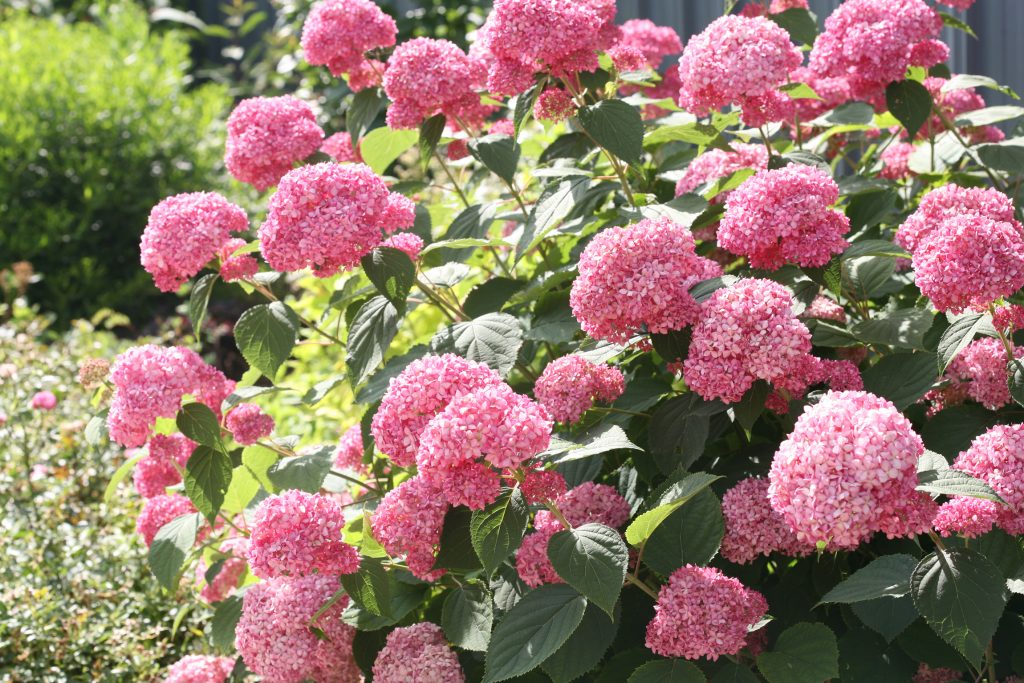
Hydrangea arborescens magical pinkerbell
- Powdery mildew. Signs - white bloom on the stems, leaves, darkens over time, the affected parts die off.Bordeaux liquid or copper sulfate will help to cope with this sore.
- Rust. Red or brown growths all over the crown are a sure sign of infection. First, the parts damaged by the fungus are removed, then irrigated with Ridomil Gold, Skor or Topaz.
- From pests on the surface of leaves, stems, aphids, spider mites, scale insects, mealybugs can appear. Treatment with insecticides is required - Aktellik, Aktara, Karbofos or Fitoverm.
For prevention, it is worth buying healthy seedlings, avoiding thickening when planting them, removing weeds on time, loosening the soil and cutting out diseased areas.
Application in garden design
The Magic Pinkerbell variety is used in different compositions in the garden:
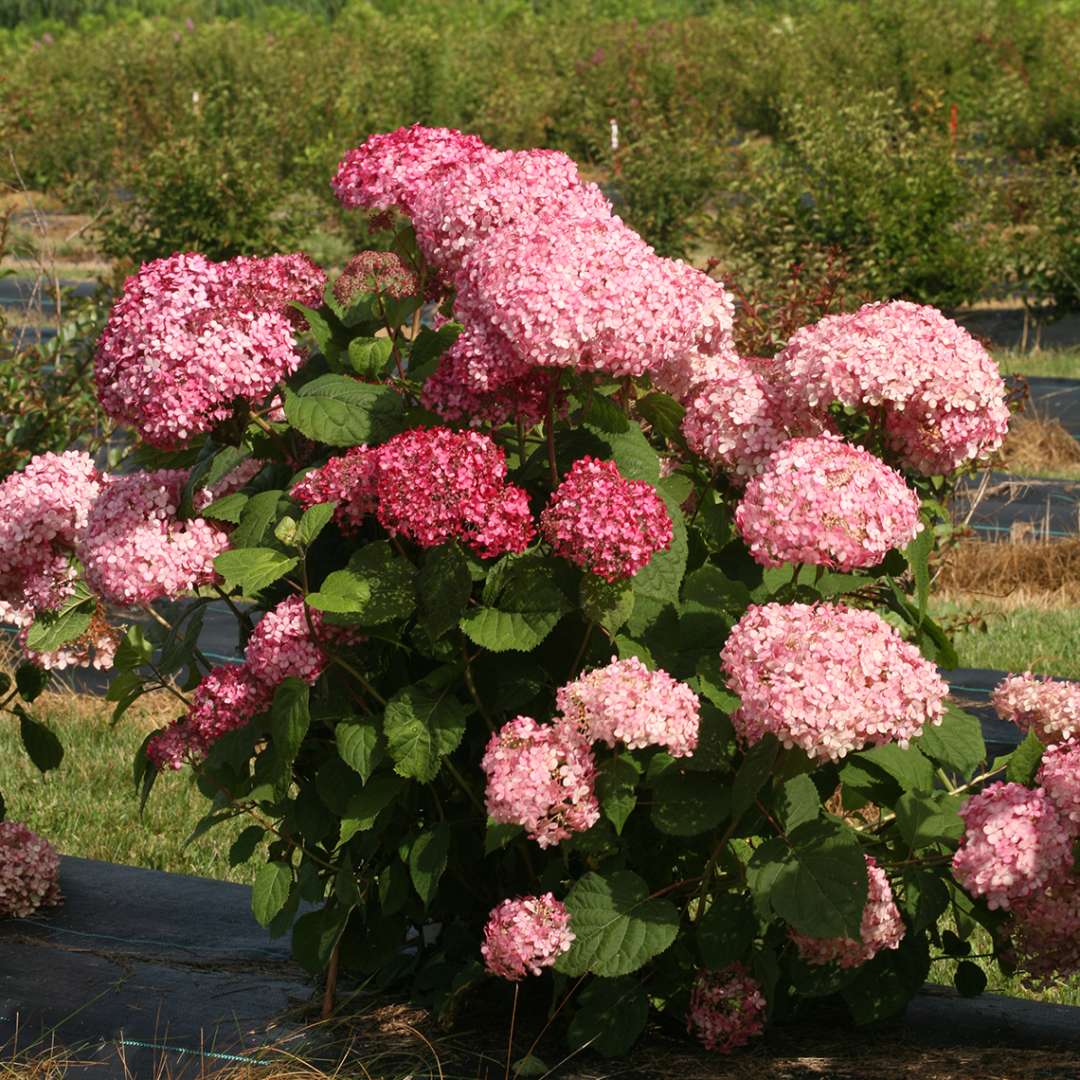
Hydrangea tree series luxury magical pinkerbell
- planted in the center of the site, flower beds, in places that are inconspicuous and need bright landscaping;
- planted in groups in a row, creating a multi-colored and dense hedge of several varieties;
- used to decorate the local area, near gazebos, terraces;
- grown together with other vegetation - junipers, firs, rhododendrons, azaleas and roses.
Variety reviews
Thanks to positive reviews, this perennial has become widespread in private gardening:
- good winter hardiness and frost resistance allows it to be cultivated in different climatic zones;
- successful reproduction by cuttings, layering and root, makes it possible to independently breed many new bushes for landscaping the garden;
- perfectly tolerates the neighborhood of other plants, therefore it is suitable for creating different compositions.

